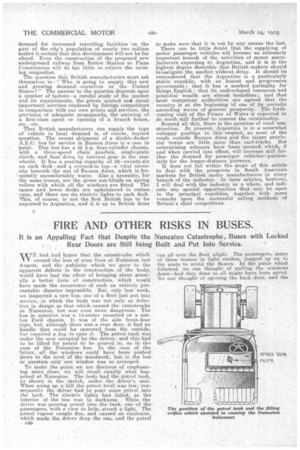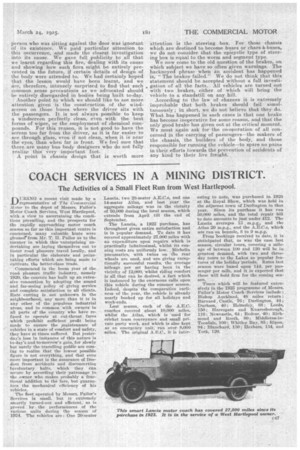FIRE AND OTHER RISKS IN BUSES.
Page 30

Page 31

If you've noticed an error in this article please click here to report it so we can fix it.
\VT had had hopes that the catastrophe which V caused the loss of nine lives at Nuneaton last August, and the publicity which we gave to the apparent defects in the construction of the body, would have had the effect of bringing about generally a better form of construction, which would have made the recurrence of such an entirely preventable diaaster impossible. But, only last week, we inspected a new bus, one of a fleet just put into service, in which the body was not only as defective in design as that which caused the catastrophe at Nuneaton, but was even more dangerous. The bus in question was a 14-seater mounted on a oneton Ford chassis. It was of the side front-door type, but, although there was a rear door, it had no handle that could be operated from the outside, but required a key to open it. The petrol tank was under the seat occupied by the driver, and this had to be lifted for petrol to be poured in, as in the case of the Nuneaton bus. In the case of the ilatter, all the windows could have been pushed down to the level of the woodwork, but in the bus in question only one window was so arranged.
To make the point we are desirous of emphasizing more clear, we will recall exactly what happened at Nuneaton. The body had the Petrol tank, as Shown in the sketch, under the driver's seat. When going up a hill the petrol level was low; consequently the driver had to pour some petrol into the tank. The electric lights had failed, so the interior of the bus was in darkness. While the driver was pouring petrol into the tank, one of the passengers, with a view to help, struck a light. The petrol vapour caught fire, and caused an explosion, which made, the driver drop the can, and the petrol
016 ran all over the floor alight. The passengers, many of them women in light clothes, jumped up on to the seats to avoid the flames. In the panic which followed, no one thought of pulling the windows down—had they done so all might have been saved. No one thought of opening the back door, and the person.who was sitting against the door was ignorant of its existence. We paid particular attention to this occurrence, and made the closest investigation into its cause. We gave full publicity to all that we learnt regarding this fire, dealing with its cause and showing how such fires might be entirely prevented in the future, if certain details of design of the body were attended to. We had certainly hoped that the lesson would have been learnt, and we are, therefore, intensely surprised to find that such common sense precautions as we advocated should be entirely disregarded in bodies being built to-day. Another point to which we should like to see more attention given is the construction of the windscreen on those buses where the driver sits with the passengers. It is not always possible to keep a windscreen perfectly clean, even with the best forms of wiper, or the employment of chemical compounds. For this reason, it is not good to have the screen too far from the driver, as it is far easier to see through glass, even if not clean, when it is near the eyes, than when far in front. We feel sure that there are many bus body designers who do not fully realize thiS very important fact. , A point in chassis design that is worth more attention is the steering box. For those chassis which are destined to become buses or chars-à-bancs, we do not consider that the epicyclic type of steering._box is equal to the worm and segment type. We now come to the old question of the brakes, on which subject we have so often given warnings. The hackneyed phrase when an accident has happened is, " The brakes failed." We do not think that this statement should be accepted without a full investigation of all the facts. All vehicles are turned out with two brakes, either of which will bring the vehicle to a standstill on any hill.
According to the law of chances it is extremely improbable that both brakes should fail simultaneously ; in short, we do not believe that they do. What has happened in such cases is that one brake has become inoperative for some reason, and that the only good brake has given out at the critical moment. We must again ask for the co-operation of all concerned in the carrying of passengers—the makers of the chassis, the builders of the body, and those responsible for running the vehicle—to spare no pains in their efforts towards the prevention of accidents of any kind to their live freight.
























































